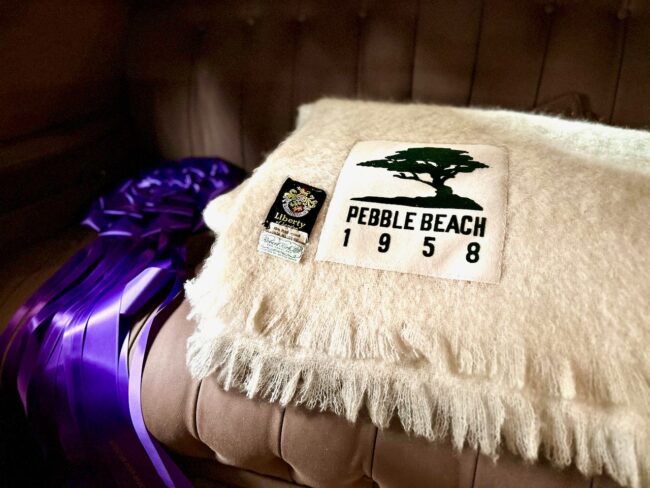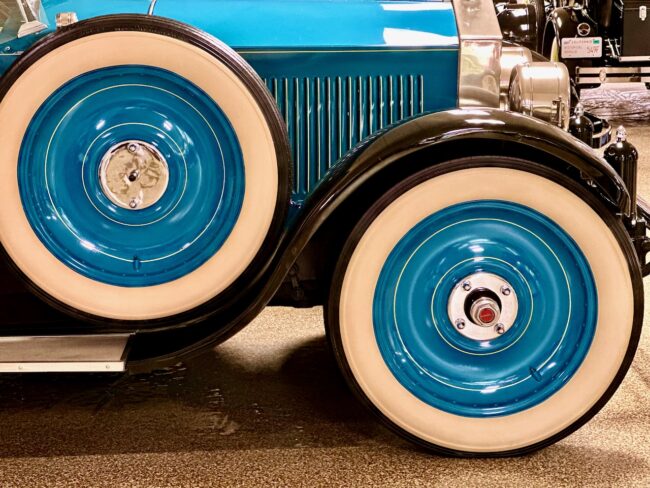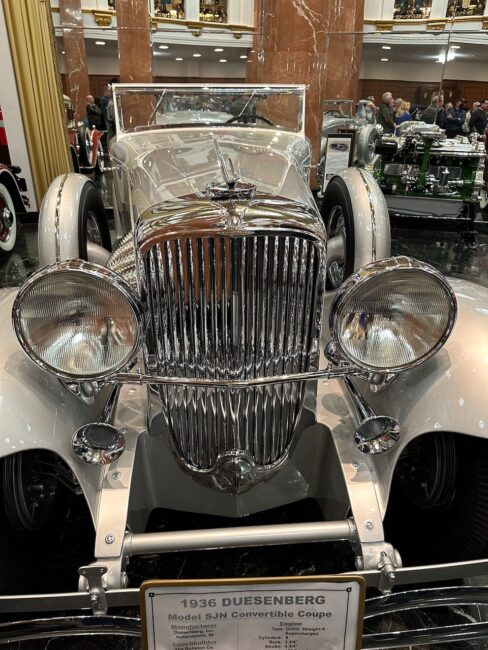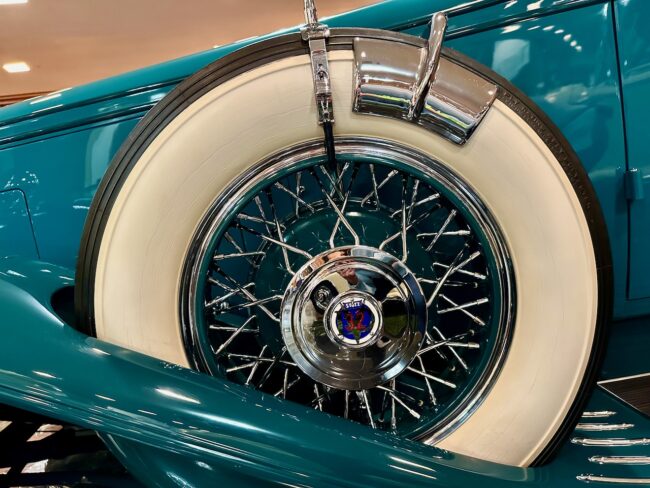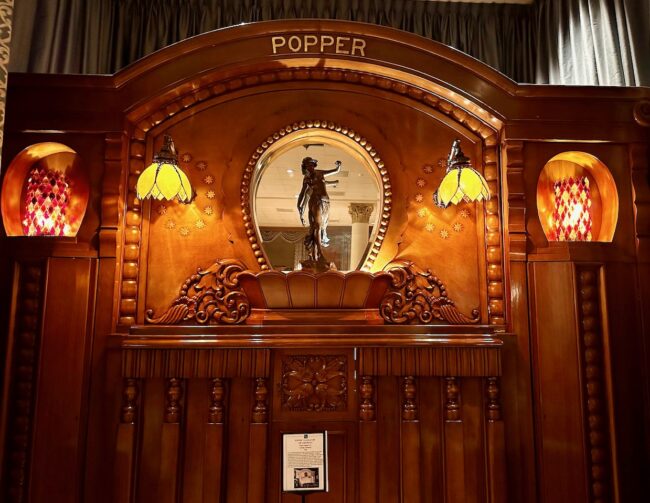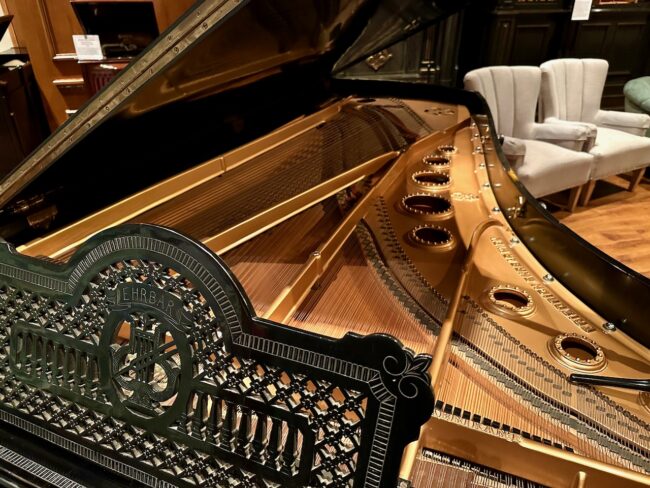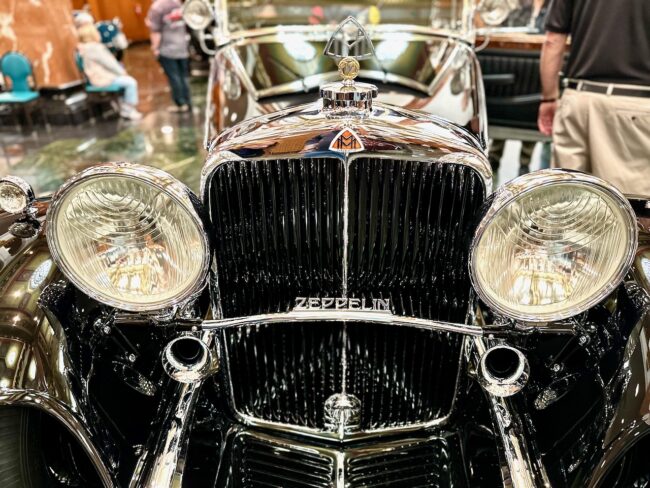
Cheech Marin Center for Chicano Art & Culture of the Riverside Art Museum – Riverside
January 8, 2023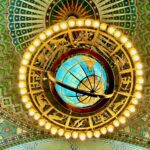
Los Angeles Central Library – Los Angeles
September 20, 2023Still The Best Museum You’ve Never Heard Of!
The Nethercutt Collection – Sylmar
Last Visited: March 2023
Who knew that because so many women use a certain cosmetic product line that we would be allowed to visit one of the coolest museums most people don’t even know exists? Located in Sylmar, California, The Nethercutt Collection houses what it calls “functional fine art.” If you like pristine vintage automobiles and unique antique mechanical music instruments that will blow your mind, this is the place. I had visited here seven years ago and talked Tracy and friends Valerie, Alex and Jeff to return to see what’s new (or to be technically correct, see what’s old).
In 1923, 10-year-old J.B. Nethercutt moved to Santa Monica from South Bend, Indiana, to live with his aunt, Merle Nethercutt Norman, who also happened to be the founder of Merle Norman Cosmetics. Fast forward to 1933, when J.B. married Dorothy Sykes, and the couple (who were married for more than 70 years) started their love affair both with each other and classic cars.
Over the ensuing years, several of their vehicles have been exhibited at events such as the Concours d’Elegance (which Tracy actually attended in Pebble Beach in the 1980s with some other guy). We learned the cars must be in flawless, original condition just like they would have been on the showroom floor. Each car starts with a perfect score of 100 points and then points are deducted for flaws and errors. According to our docent, Nethercutt cars have never had any deductions.

The collecting became more serious in the 1950s. By then, the Nethercutts, who were rolling in dough (foundation?) thanks to the cosmetics business, purchased a 1936 Duesenberg Convertible Roadster for $5,000, together with a 1930 DuPont Town Car for $500 (which took $63,000 to restore). The DuPont Town Car was entered into the 1958 Pebble Beach Concours d’Elegance where it won “Best in Show.” Nethercutt cars have since won more “Best in Shows” than any other collector in the world.
The collection grew exponentially from there. In 1971, the Nethercutts opened their museum in Sylmar that now features more than 260 vintage cars and “a world-class collection of automated mechanical instruments” not to mention a locomotive and private car housed out back. Let the journey begin. We arrived at 9 a.m. to visit the museum. At 10 a.m. we would take a tour of “The Collection,” which includes even more incredible cars and a host of old-time, “self-contained orchestra pieces.” (The museum is free but the Collection tour is $10 and reservations are required.)
First the museum. Upon entering prepared to be wowed by 120 of those gorgeous automobiles, all in pristine condition.Many of these automobiles tell a tale from the past (well, actually the placards next to them tell the story). Here are just a few. We were over the moon for this 1911 Moon Model Thirty Toy Tonneau, the third oldest Moon automobile known to exist.
Silent movie comedian, the infamous Roscoe “Fatty” Arbuckle, was supposedly the first owner of this 1923 McFarlan Knickerbocker Cabriolet. It is said that the car trunk was easily accessible from the inside so “Fatty could have his favorite libation close at hand.”
This 1938 Cadillac Convertible Sedan’s original owner was Polish opera singer Madame Ganna Walska.
Mai Tai Tom Tip: We highly recommend a visit to Madame Walska’s truly amazing estate and botanic gardens, Lotusland, in Montecito, California (near Santa Barbara). Here is our report from when we visited Lotusland.
This 1930 Rolls-Royce Phantom II Town car was featured in the 1937 film, The King & The Chorus Girl. It was owned by famed actress Constance Bennett.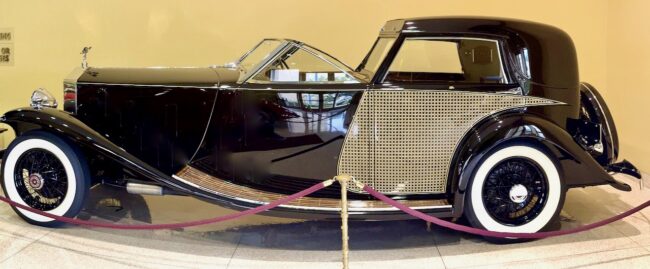
Although we didn’t see it on our recent visit, when I was here in 2016 I got a good look at a 1928 Minerva from Belgium, that was owned by General Billy Mitchell, “The Father of the United States Air Force.” Looks like his ground transportation was pretty slick, too.
I don’t believe Paul Anka was singing about this 1928 Diana Sedan Deluxe which had the same name as his 1957 hit record. This Diana was named after the Goddess of the Moon.
While the San Diego Padres never won much while he was their owner, C. Arnolt Smith at least had the solace of owning this 1936 Pierce-Arrow Imperial Salon Limousine. His chauffeur would drive him from his home in Pasadena down to the Del Mar Race Track and then onto Padres games in San Diego. Presumably, he had better luck at the track than he did at the stadium.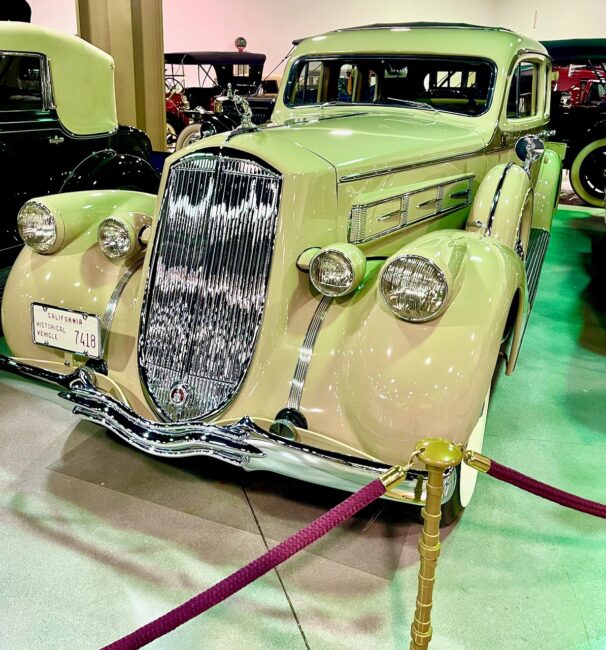
Talk about putting miles on a car. The 1930 Minerva Limousine de Ville racked up 300,000 miles between 1931 and 1939. The reason? Its owners, a French lecturer and his wife, purchased this car to drive from Cape Horn to Alaska. They gave up and sold the car in British Columbia. I guess they had just too much alone time with each other, because shortly after selling the car they got an accelerated divorce.
We even went Back To The Future, but we had no time for me to play Johnny B. Goode.
We checked out the 1913 Christie Front-Drive Steam Pumper Fire Engine that helped extinguish fires for the Somerset, Massachusetts Fire Department for more than four decades.
Heiress and daughter of Frank Woolworth, Jessie Woolworth Donahue, was obviously worth more than five or ten cents, as she purchased this 1932 Rolls-Royce Phantom II Croydan Victoria as a gift for her husband.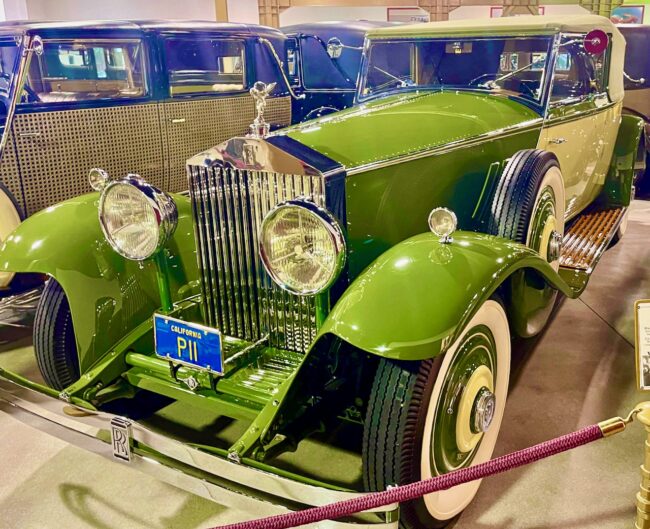
The hood ornaments on some of these cars …
… were just as interesting and beautiful as the automobiles.
A 1932 Chrysler Frill Town car was one of only 152 model CH Convertible Sedans, and the “only blue Chrysler Custom Imperial” sold in Los Angeles. Nethercutt purchased the vehicle and restored it more than three decades after he first saw it cruising the streets of LA.
Our docent told us that all the cars and orchestra machines are in working order, hence “functional fine art.” All restoration and service is conducted onsite by three automobile craftsmen who can create or repair anything except the glass, tires and the chrome or nickel plating. There are also two drivers as the cars must be driven at least once a year to be kept in pristine condition. He added that one of the Duesenbergs (maybe this one) was driven on the 210 freeway up to 110 mph and could have gone even faster. Check out the rear windshield that kept backseat passengers comfortable of this 1969 Pebble Beach Concours’ winner.
There were many more cars to see, but it was time to cross the street to tour “The Collection.” The two-hour Collection tour starts in the Lower Salon. Once again vintage automobiles were the star, but they were joined by some unique musical machines. These would only be the precursors to the mammoth musical “orchestrations” we would listen to upstairs. Some of them, like this 1825 Schleip Lyra-Flugal Piano, were playing while viewing the cars in the Lower Salon.
You could have picked up this 1931 Ford, Model A Deluxe Phaeton 180A for $80 plus accessories when new.
People on the tour were guessing who was older, me or the car.
Maybe the orchestration machines should have been playing Rhapsody In Blue.
The 1905 Franklin below was driven from San Francisco to New York City in 33 days in 1904, breaking the record held by Packard by more than a month.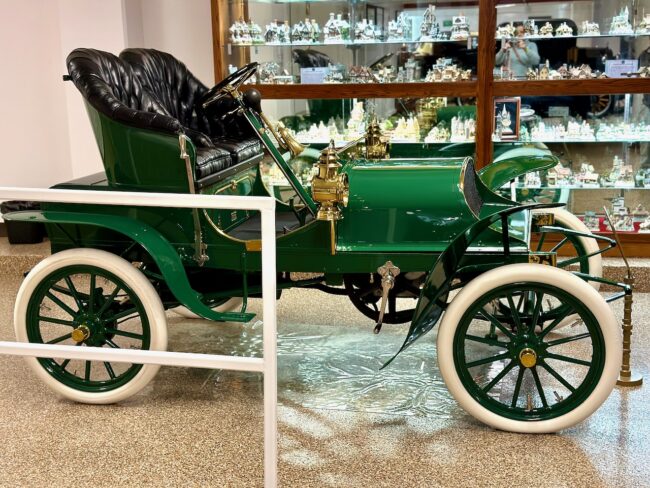
We checked out a 1905 Buick and a 1903 Peerless.
Tracy said I would be crazy to buy a 1923 Locomobile.
I grilled Tracy about this 1905 Franklin …
… but now it was time to ascend to the “Grand Salon.” Tracy tells us a little bit about it in this very short video.
And “grand” it is. The marble columns, crystal chandeliers and painted ceilings transport you to the 1920s. The salon was “architecturally inspired by a mix of 1920s-30s New York City luxury car showrooms, grand ballrooms and opulent theaters.” This room features the crème de la crème of its extensive automobile collection worth more than $100 million bucks in this room alone! That’s a lot of lipstick!
It took the Nethercutt craftsmen two years to restore this 1934 Packard that was discovered rusted out in Wisconsin. There are only four of these Packards left in the world. Another interesting factoid about this car is that J.B. Nethercutt absolutely fell in love with this color, so much so that he “had the chemists at Merle Norman Cosmetics develop a lipstick, nail polish and perfume to match.”
Restoration, which is done in-house, usually takes about two years and each car must be painted in historically accurate colors. The cars are dusted every three days, even underneath, by a team of three people. There are no tours of the 30,000 square-foot car restoration complex (unless, of course, you’re Jay Leno).
Speaking of Jay Leno, I was looking for the 1933 Rollston Arlington Torpedo-bodied Duesenberg SJ ultra-luxury sedan (dubbed the “Twenty Grand” and “The Most Famous Duesenberg of All Time” because of its sales price.) I couldn’t find it, probably because that it was recently featured on an episode of Jay Leno’s Garage. Here is a photo from the Nethercutt website.
This 1932 Maybach DS8 Zeppelin Sport Cabriolet was co-designed by Count Ferdinand Von Zeppelin, inventor of the Zeppelin rigid airships. I’m sure he gave this Zeppelin a Whole Lotta Love. Oh, the humanity!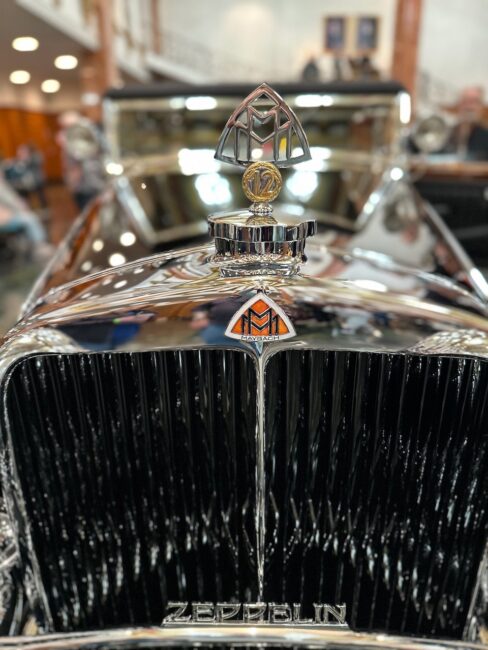
Back in the day, there were an unlimited amount of paint combinations that could be used for Packards. The below 1934 Packard 1108 Twelve Convertible Sedan certainly stood out.
As we toured the “showroom,” a medley of songs from the 20s and 30s played on the piano halfway up a staircase to the next level.
Even at home, Tracy can’t resist a colorful ceiling.
We marveled at the detail that went into the construction of the Grand Salon.
Here’s one of those two cars that Nethercutt bought to start the collection. You might have seen this 1936 Duesenberg Convertible Coupe if you happened to watch the 1949 version of The Great Gatsby starring Alan Ladd.
And what about that first car Nethercutt bought that won Best of Show at the 1958 Pebble Beach Concours? Well, that 1930 DuPont Model G Town Car is still here. Nethercutt sold the car in 1962 and then bought it back in 2000 after it was featured as Daddy Warbuck’s car in the 1982 movie Annie. Although only a day away, I couldn’t wait until Tomorrow to see it.
This 1931 Bugatti Dubos Coupe has won numerous awards.
I’d never heard of a Ruxton before and that might be because only 134 cars were produced in the single year the company was in business. This 1930 Ruxton won First in Class & Best American Classic at Pebble Beach in 2006.
This 1931 Stutz Sedan captured first place in the 1978 Pebble Beach Concours d’Elegance.
For good reason.
The array of cars in this room are stunning …
… and you are allotted plenty of time here to see each and every car.
This area, too, has its share of vintage musical instruments, including a 1927 Steinway Grand Piano, which can be played automatically, plus this colorful orchestration.
The next level up is the mezzanine, which contains an assortment of smaller musical instruments, music boxes, crystal and more.
The highlight of the mezzanine would be the “Spirit Of The West,” which was made for the 1915 Panama Pacific Exposition in San Francisco. The sculpture celebrates the World Fair, the opening of the Panama Canal, railroads and the United States’ bread basket. The 600-pound sculpture was damaged in a fire and then purchased and restored by none other than the craftsmen who work on the Nethercutt automobiles.
As we climbed the musically inspired staircase (dubbed the Stairway to the Stars) …
… I crooned to Tracy on the Spiral Staircase, “I love you more today than yesterday, but not as much as tomorrow.”
Before entering the Music Room we listened to a 1917 Seeburg Automatic Orchestra Nickelodeon. It’s difficult to explain how cool all these instruments sound. For instance, this one contains a piano, mandolin, pipes, bass-drum, snare-drum, tympany, triangle and can play a ten-tune paper roll. And this was just the beginning.
By now we were on the top floor that was specifically added to the museum to house the Wurlitzer theater pipe organ that J.B. Nethercutt fell madly in love with. The story goes that the owners were reluctant to part with it until J.B.’s check got too big to decline.
I assumed these musical watches were used to keep time to the music.
In a corner of the Music Room is a Louis XV-inspired dining room where the Nethercutts hosted elaborate dinner parties on Friday nights. An opulent Louis XV chandelier (the oldest piece in the Collection) illuminates the dining area.
We listened to some of the orchestrations in the room while we took a look.
These dining chairs only have one arm, just like the real killer in The Fugitive. The reason? Our tour guide told us that men would wear their swords on the left side to dinner; thus the chair only had one arm to accommodate the sword.
We walked around the Music room, which features pianos, Nickelodeons, Disc Music Boxes and Orchestrations. Some of these European Orchestrations covered an entire wall and sounded like a symphony orchestra was playing inside the room. You really have to visit to experience it. Words do not do justice to these self-contained orchestra pieces…and the incredible music they play. The 1923 Popper “Gladiator” Orchestration (left) is the last remaining one in the world, while the 1910 Welte “Wotan” Brass Band Orchestration is the only one known to exist in the world and had to be cut into pieces to remove it from its original location and then completely reassembled and restored by the Nethercutt.
The German 1926 Hupfield “Excelsior Pan” Orchestra has the sound of a 20-piece orchestra. I told you these things were unbelievable.
Below is a piano presented to Emperor Franz Josef of Austria to commemorate the Golden Jubilee of his reign in 1898.
It’s decorated with an ample amount of brass designs.
Walk a few feet around the room and you’re at a different orchestra piece.
If you own a piano, it has 88 keys. Not this one. This 1981 Bosendorfer Imperial Grand Piano made in Indiana has 97 keys, and is one of the first pianos ever to have a computer attached. I heard it play on my first trip here and the sound was remarkable.
A few more unique orchestrations were seen, but now it was time for the grand finale.
The big-ticket item in the room is the 5,000 pipe (5,321 pipes to be exact which are housed in 11 rooms scattered around the floor) Mighty Wurlitzer Theater Organ. This organ (built in 1907) played in theaters showing silent movies providing both music and sound effects for the audience. The Mighty Wurlitzer was designed to “take you to [a] place special” to “escape.” According to the Nethercutt, this is the third largest theatre pipe organ in the world. The largest has nearly 6,000 pipes and currently resides in a pizza parlor in Mesa, Arizona (www.organstoppizza.com) where it is played nightly for your dining pleasure.
Our docent demonstrated some of the sound effects of the organ which was retired from the theater in 1940. Jeff and I offered to play a duet.
For our tour, a medley from Phantom of the Opera was played as well as music from the Pink Panther and Raiders of the Lost Ark. The music soared around us as curtains opened to reveal some of the hidden and colorfully lit pipes.
Emperor Franz Josef’s piano looked even better during the light show.
It was almost noon, so we headed back across the street to the museum, but it was going to be another half hour before we could tour the train. Hunger took over, so the Cliffs Notes version is that this is Canadian Pacific Railway’s famous Royal Hudson steam locomotive, one of only four left in existence.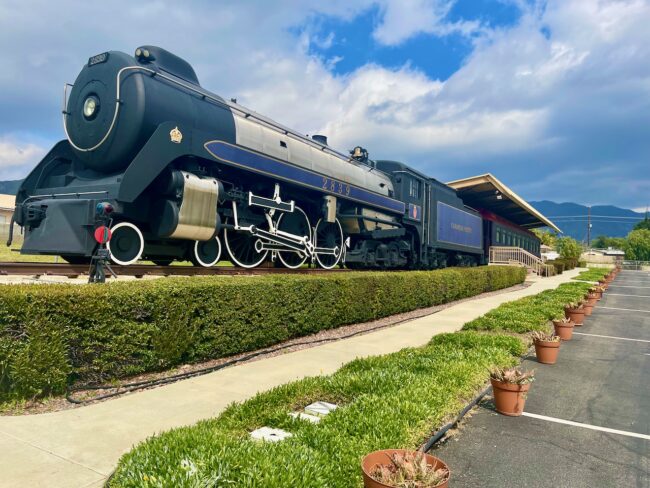
You’re allotted about 15 minutes to climb inside a 1912 Pullman Railcar owned by Clara Baldwin Stocker, who was the eldest daughter of E.J. “Lucky” Baldwin (see my report on the Los Angeles County Arboretum & Botanical Gardens in California Dreaming for more about Lucky). Here’s a couple of photos from my visit in 2016.
As we exited the museum we checked out a few more cars including a 1923 Voison C-5 Sporting Victoria, which was Rudolph Valentino’s car of choice. He had two in Paris, and one in Hollywood.
I felt like a Prince looking at this little red Corvette from 1957.
All these cars cost a lot of cash, and the Nethercutt even has a 1915 National Cash Register. Why is the “C” missing on the drawers? “C” is missing because “C” stood for cash, and they were all cash drawers.
Our three-plus hours at the Nethercutt Collection had ended, but not before getting up close to some of the most spectacular automobiles in the world, and listening to the sweetest sounding automated musical instruments you will ever hear. I find it amazing that so many people, including many fellow Southern Californians, have never heard of or visited this spectacular museum.’
There’s literally cars from A – Z.
As far as museums go, and as I’ve stated before, this museum and collection is a cut (or should I say a “Nethercutt”) above!
 In other words, you really “auto” go.
In other words, you really “auto” go.
The Nethercutt Collection
15200 Bledsoe Street
Sylmar, California 91342
Phone: 818.364.6464
Museum Hours: Thursday – Saturday – Saturday 9 a.m. to 4:30 p.m.
Museum Cost: Free
Collection Tour: $10
The Collection is only available to view by guided tour only.
Tours are available on: Thursday, & Friday at 10 am
Saturday 10:00 a.m. or 1:30 p.m. ADVANCED RESERVATIONS ONLY
Locomotive & Pullman Car Visit: Thursday – Saturday 12:30 & 3:45
Not handicapped accessible
No Walkers, Strollers, Wheelchairs
Parking: Free
Website: http://nethercuttcollection.org






